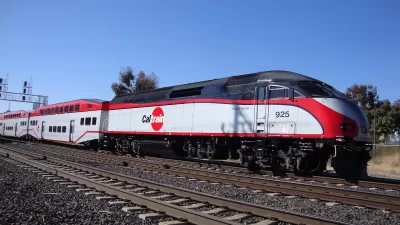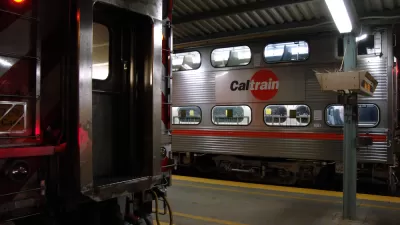Electrification of the Caltrain will be great for train riders, the environment, air quality, and public health, but it might worsen traffic congestion between San Jose and San Francisco by increasing the frequency of commuter trains.
Motorists stuck behind closed train gates may not be happy to hear that wait times may increase as a result of Caltrain electrification. It's not due to the trains themselves—as electrified trains will travel faster than diesel-powered trains due to speedier acceleration and deceleration; rather, it's that Caltrain will be running more trains, which means more "down time" for those gates.
Consequently, "seven of the 82 intersections between San Francisco and San Jose would see 'significant and unavoidable' impacts, according to a final environmental impact report prepared for the project," writes Jason Green of the Bay Area News Group.
The Peninsula Corridor Electrification Project is part of a $1.5 billion Caltrain Modernization Program that includes positive train control. "It will enable Caltrain to boost its ridership from roughly 60,000 today to more than 110,000 by 2040, according to the agency's projections," writes Green.
The only additional benefit to the program listed by Green is that it "is also expected to 176,000 metric tons of carbon dioxide from the atmosphere." The remainder of the article is devoted to increased congestion at particular grade crossings in Palo Alto, Mountain View, Sunnyvale and Burlingame.
The increased congestion is listed in the newly released Final Environmental Impact Report (FEIR) for the project, a requirement of the California Environmental Quality Act, or CEQA.
One solution is to build grade separations, but "Caltrain said the price tag was too high," writes Green. "Constructing grade separations at each of the seven intersections would cost between $350 million and $700 million."
"While grade separations are a technically feasible way to reduce traffic impacts at the at-grade locations, it is a highly expensive mitigation strategy," the report said. "Thus, Caltrain cannot commit to a comprehensive program of grade separations at this time to address all significantly affected intersections and this impact is considered significant and unavoidable.
Hat tip to MTC-ABAG Library.
FULL STORY: Report: Caltrain electrification to cause 'significant and unavoidable' impacts at certain intersections

Maui's Vacation Rental Debate Turns Ugly
Verbal attacks, misinformation campaigns and fistfights plague a high-stakes debate to convert thousands of vacation rentals into long-term housing.

Planetizen Federal Action Tracker
A weekly monitor of how Trump’s orders and actions are impacting planners and planning in America.

San Francisco Suspends Traffic Calming Amidst Record Deaths
Citing “a challenging fiscal landscape,” the city will cease the program on the heels of 42 traffic deaths, including 24 pedestrians.

Defunct Pittsburgh Power Plant to Become Residential Tower
A decommissioned steam heat plant will be redeveloped into almost 100 affordable housing units.

Trump Prompts Restructuring of Transportation Research Board in “Unprecedented Overreach”
The TRB has eliminated more than half of its committees including those focused on climate, equity, and cities.

Amtrak Rolls Out New Orleans to Alabama “Mardi Gras” Train
The new service will operate morning and evening departures between Mobile and New Orleans.
Urban Design for Planners 1: Software Tools
This six-course series explores essential urban design concepts using open source software and equips planners with the tools they need to participate fully in the urban design process.
Planning for Universal Design
Learn the tools for implementing Universal Design in planning regulations.
Heyer Gruel & Associates PA
JM Goldson LLC
Custer County Colorado
City of Camden Redevelopment Agency
City of Astoria
Transportation Research & Education Center (TREC) at Portland State University
Jefferson Parish Government
Camden Redevelopment Agency
City of Claremont




























